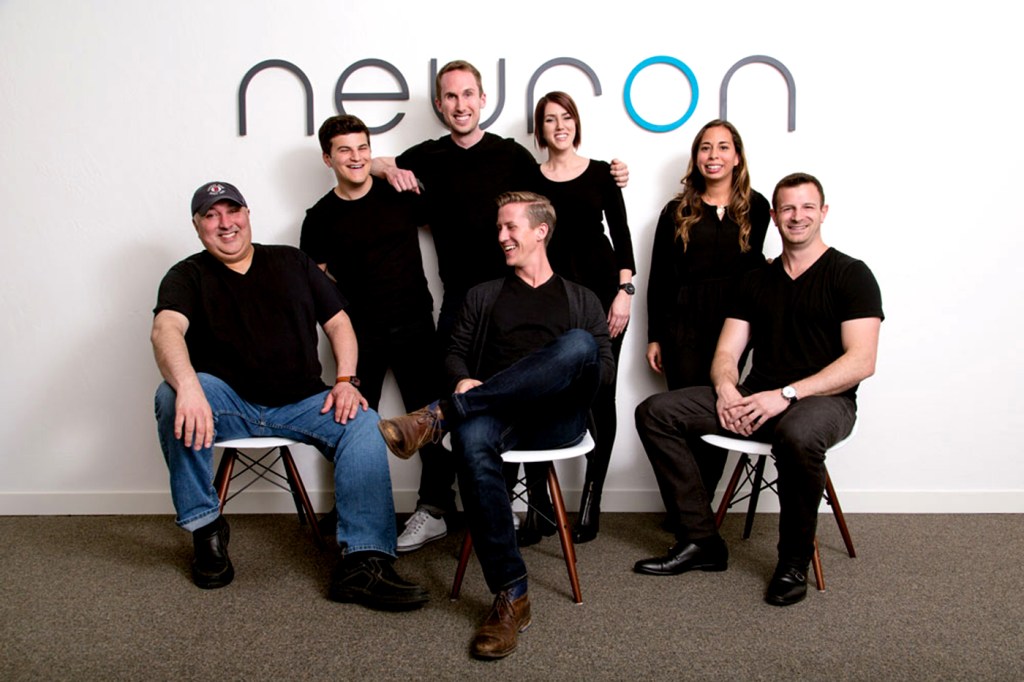Designing software and smartphone apps with an architect’s touch

In the San Francisco office that houses their tech startup, four Northeastern graduates who studied architecture spend their days drawing up plans and contemplating functionality and aesthetics. But they’re not designing buildings, roads, or landscapes; they’re creating applications for smartphones, software, and blockchain platforms.
Chris Marciano, Ryan Matthew, Mark Munroe, and Matt Stoner have created a website for Projects for Good, an organization whose clients tackle complex humanitarian projects; they have designed the software for a competitive sales portal for employees of a smart home company; and they are developing an interactive mobile app to help native Chinese speakers learn English.
Their company, Neuron, specializes in improving how users interact with digital products and services. Most companies in this business rely on the work of graphic designers and web developers, says Marciano. But he and his co-founders draw from a shared background in architecture education that they received at Northeastern.
They contend that knowing how to design physical spaces is the secret behind their success in the digital realm and that this knowledge has helped them create a company that stands out from competitors.
“Northeastern prepared us with strong fundamentals in design thinking, both in the classroom and while on co-op,” says Marciano, who graduated from Northeastern in 2014 with a master’s degree in architecture. “We now apply this background in architecture to the design of digital products and services.”
Northeastern prepared us with strong fundamentals in design thinking, both in the classroom and while on co-op.
Chris Marciano, co-founder and senior UX designer, Neuron
The team, which also includes co-founder Soudy Khan, creates a blueprint for each project to show Neuron’s clients how products will be used before they get coded.
Munroe likens the process of creating a digital product to designing an apartment building.
“Architecture allows us to think about user experience design in a very different way,” says Munroe, who graduated from Northeastern in 2014 with a master’s degree in architecture. “When scaled, these pieces form the basic framework for creating the more complex overall experience of the building. It’s a similar logic and thought process behind great product design. The best digital experiences are consistent, coherent, and provide context and clues throughout.”
The road the entrepreneurs took from Boston to Silicon Valley wasn’t a straight shot. After graduating from Northeastern, Marciano, Matthew, Munroe, and Stoner worked for traditional architecture firms on the East Coast before founding Neuron in Seattle in 2016.
But they met at Northeastern, developed a close friendship, and honed their ability to work together by collaborating on their senior thesis project in 2013, which snagged the $1,000 grand prize at Northeastern’s Research, Innovation, and Scholarship Expo, an annual event that showcases the best in student and faculty projects.
“Coming out of Northeastern’s architecture school, we’re all very creative and design oriented and really thrive off of solving challenging problems,” says Stoner, who graduated from Northeastern in 2013 with his bachelor’s degree in architecture. “I think that transitioning from the problem of architecture to the problem of user experience and design for technology was a natural one for us. It presented a new challenge in a new industry that satisfied our curiosities with technology and the cross-pollination of the physical world and the digital world and how we could implement that.”
For media inquiries, please contact media@northeastern.edu.





